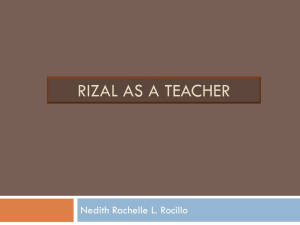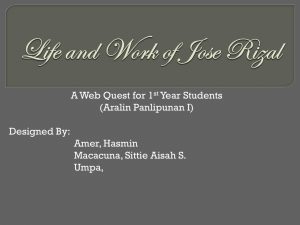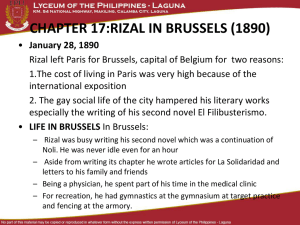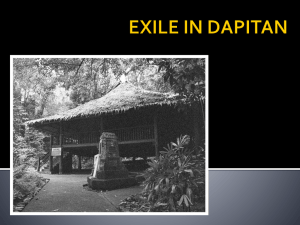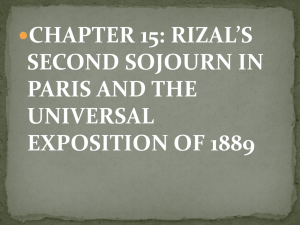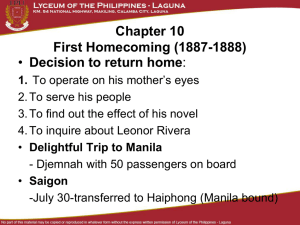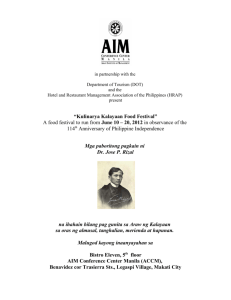Da Pinoy Chronicle: Jose Rizal and His Lovers
advertisement
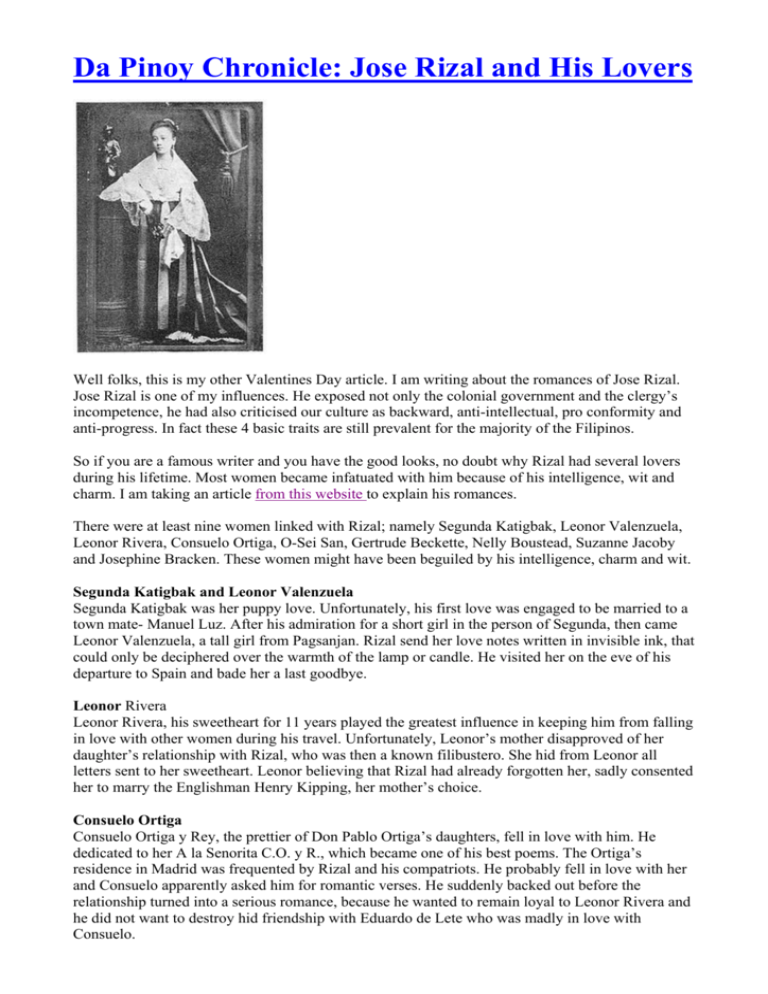
Da Pinoy Chronicle: Jose Rizal and His Lovers Well folks, this is my other Valentines Day article. I am writing about the romances of Jose Rizal. Jose Rizal is one of my influences. He exposed not only the colonial government and the clergy’s incompetence, he had also criticised our culture as backward, anti-intellectual, pro conformity and anti-progress. In fact these 4 basic traits are still prevalent for the majority of the Filipinos. So if you are a famous writer and you have the good looks, no doubt why Rizal had several lovers during his lifetime. Most women became infatuated with him because of his intelligence, wit and charm. I am taking an article from this website to explain his romances. There were at least nine women linked with Rizal; namely Segunda Katigbak, Leonor Valenzuela, Leonor Rivera, Consuelo Ortiga, O-Sei San, Gertrude Beckette, Nelly Boustead, Suzanne Jacoby and Josephine Bracken. These women might have been beguiled by his intelligence, charm and wit. Segunda Katigbak and Leonor Valenzuela Segunda Katigbak was her puppy love. Unfortunately, his first love was engaged to be married to a town mate- Manuel Luz. After his admiration for a short girl in the person of Segunda, then came Leonor Valenzuela, a tall girl from Pagsanjan. Rizal send her love notes written in invisible ink, that could only be deciphered over the warmth of the lamp or candle. He visited her on the eve of his departure to Spain and bade her a last goodbye. Leonor Rivera Leonor Rivera, his sweetheart for 11 years played the greatest influence in keeping him from falling in love with other women during his travel. Unfortunately, Leonor’s mother disapproved of her daughter’s relationship with Rizal, who was then a known filibustero. She hid from Leonor all letters sent to her sweetheart. Leonor believing that Rizal had already forgotten her, sadly consented her to marry the Englishman Henry Kipping, her mother’s choice. Consuelo Ortiga Consuelo Ortiga y Rey, the prettier of Don Pablo Ortiga’s daughters, fell in love with him. He dedicated to her A la Senorita C.O. y R., which became one of his best poems. The Ortiga’s residence in Madrid was frequented by Rizal and his compatriots. He probably fell in love with her and Consuelo apparently asked him for romantic verses. He suddenly backed out before the relationship turned into a serious romance, because he wanted to remain loyal to Leonor Rivera and he did not want to destroy hid friendship with Eduardo de Lete who was madly in love with Consuelo. O Sei San O Sei San, a Japanese samurai’s daughter taught Rizal the Japanese art of painting known as sumie. She also helped Rizal improve his knowledge of Japanese language. If Rizal was a man without a patriotic mission, he would have married this lovely and intelligent woman and lived a stable and happy life with her in Japan because Spanish legation there offered him a lucrative job. Gertrude Beckett While Rizal was in London annotating the Sucesos de las Islas Filipinas, he boarded in the house of the Beckett family, within walking distance of the British Museum. Gertrude, a blue-eyed and buxom girl was the oldest of the three Beckett daughters. She fell in love with Rizal. Tottie helped him in his painting and sculpture. But Rizal suddenly left London for Paris to avoid Gertrude, who was seriously in love with him. Before leaving London, he was able to finish the group carving of the Beckett sisters. He gave the group carving to Gertrude as a sign of their brief relationship. Nellie Boustead Rizal having lost Leonor Rivera, entertained the thought of courting other ladies. While a guest of the Boustead family at their residence in the resort city of Biarritz, he had befriended the two pretty daughters of his host, Eduardo Boustead. Rizal used to fence with the sisters at the studio of Juan Luna. Antonio Luna, Juan’s brother and also a frequent visitor of the Bousteads, courted Nellie but she was deeply infatuated with Rizal. In a party held by Filipinos in Madrid, a drunken Antonio Luna uttered unsavory remarks against Nellie Boustead. This prompted Rizal to challenge Luna into a duel. Fortunately, Luna apologized to Rizal, thus averting tragedy for the compatriots. Their love affair unfortunately did not end in marriage. It failed because Rizal refused to be converted to the Protestant faith, as Nellie demanded and Nellie’s mother did not like a physician without enough paying clientele to be a son-in-law. The lovers, however, parted as good friends when Rizal left Europe. Suzanne Jacoby In 1890, Rizal moved to Brussels because of the high cost of living in Paris. In Brussels, he lived in the boarding house of the two Jacoby sisters. In time, they fell deeply in love with each other. Suzanne cried when Rizal left Brussels and wrote him when he was in Madrid. Josephine Bracken In the last days of February 1895, while still in Dapitan, Rizal met an 18-year old petite Irish girl, with bold blue eyes, brown hair and a happy disposition. She was Josephine Bracken, the adopted daughter of George Taufer from Hong Kong, who came to Dapitan to seek Rizal for eye treatment. Rizal was physically attracted to her. His loneliness and boredom must have taken the measure of him and what could be a better diversion that to fall in love again. But the Rizal sisters suspected Josephine as an agent of the friars and they considered her as a threat to Rizal’s security. Rizal asked Josephine to marry him, but she was not yet ready to make a decision due to her responsibility to the blind Taufer. Since Taufer’s blindness was untreatable, he left for Hon Kong on March 1895. Josephine stayed with Rizal’s family in Manila. Upon her return to Dapitan, Rizal tried to arrange with Father Antonio Obach for their marriage. However, the priest wanted a retraction as a precondition before marrying them. Rizal upon the advice of his family and friends and with Josephine’s consent took her as his wife even without the Church blessings. Josephine later give birth prematurely to a stillborn baby, a result of some incidence, which might have shocked or frightened her. The love story which captivates me is the relationship between Jose Rizal and Leonor Rivera. They were cousins and Rizal had even made her the inspiration of his character in his novels as Maria Clara. We can clearly point out the allegories of his novels Noli Me Tangere and El Filibusterismo. He created Ibarra as the picture of his idealistic side and Simoun as his cynical side. Both of them loved each other. From just being sending friendly letters to each other, it slowly became romantic. I am taking an article from Wikipedia to explain you the full details of their relationship. The correspondence between Rivera and Rizal kept Rizal focused on his studies in Europe. They employed codes in their letters because Rivera’s mother did not favor Rizal as a suitor for Rivera. A letter from Mariano Catigbac dated June 27, 1884 referred to Rivera as Rizal’s “betrothed”. Catigbac described Rivera as having been greatly affected by Rizal’s departure, frequently sick because of insomnia. When Rizal returned to the Philippines on August 5, 1887, Rivera was no longer living in Manila because she and her family had moved back to Dagupan, Pangasinan. Rizal wanted to meet Rivera and Rivera also wanted to see Rizal, but both were prohibited by their fathers. Rizal was forbidden by his father Francisco Mercado in order to avoid putting the Rivera family in danger because at the time Rizal was already labeled by the Spaniards as a filibustero or subversive because of the contents of his novel Noli Me Tangere. Rizal wanted to marry Rivera while he was still in the Philippines because of Rivera’s uncomplaining fidelity. Rizal asked permission from his father one more time before his second departure from the Philippines. The meeting never happened. In 1888, Rizal stopped receiving letters from Rivera for a year, although Rizal kept sending letters to Rivera. The reason for Rivera’s year of silence was the connivance between Rivera’s mother and the Englishman named Henry Charles Kipping, a railway engineer who fell in love with Rivera and was favoured by Rivera’s mother. We can clearly see parallels between Rivera’s mother and Dona Victorina, as well as the wedding of Kipping and Rivera in El Filibusterismo. Rizal was so angered by her last letter, he even attempted to burn the manuscripts of El Filibusterismo! It had angered Rizal than the tragedy that happened in his family in Calamba when the Spanish had forced its inhabitants to forced resettlement at the delight of the frailes. as written by his brother Paciano The marriage of Rivera to Kipping had probably influenced Rizal to turn his second novel into a dark and a thrilling masterpiece. You see, when most people are depressed their emotions and their thinking can combine together to form a work of art. Take example like Mozart’s “Requiem” and the works of Vincent Van Gogh. Rizal’s relationship with Leonor Rivera is probably one of the most depressing and interesting chapter in Rizal’s life. I can clearly see that Rizal had written his novels to express his frustration and misery in himself and in our country. He is a flawed being just like any other person. Jose Rizal had indirectly sparked the revolution of the Republicans against the Royalists in a war of independence. He was the very soul of the Revolution, the prosecutors were right. He predicted early in his childhood that he will not pass his 30′s, hew was right. He died as a hero to the citizens, a martyr. Jose Rizal overall was not divine. He is an ordinary guy with a brain like us. He was a great chickboy. Ref.: http://dapinoychronicle.wordpress.com/2013/02/14/da-pinoy-chronicle-jose-rizal-and-hislovers/ Look also here: www.History.PhilippinesHeritage.ph
